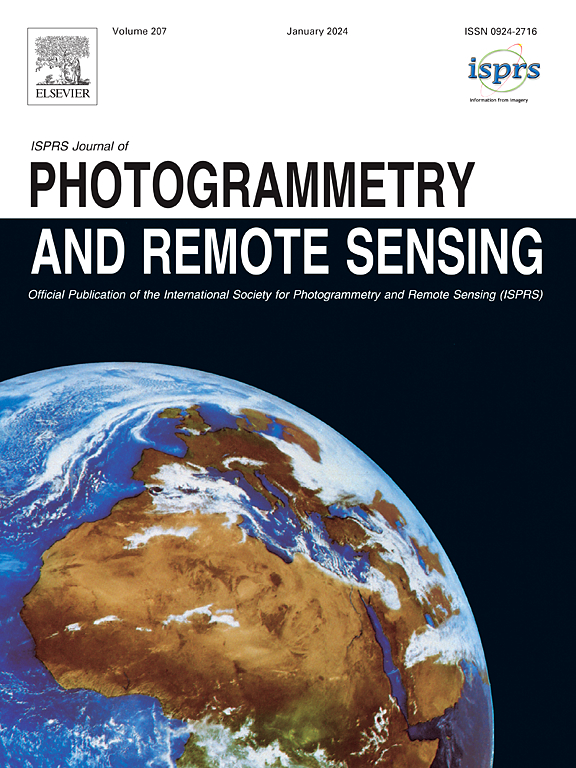Efficient metric-resolution land cover mapping using open-access low resolution annotations with prototype learning and modified Segment Anything model
IF 10.6
1区 地球科学
Q1 GEOGRAPHY, PHYSICAL
ISPRS Journal of Photogrammetry and Remote Sensing
Pub Date : 2025-03-30
DOI:10.1016/j.isprsjprs.2025.03.021
引用次数: 0
Abstract
Large-scale metric-resolution land cover mapping is crucial for a detailed understanding of large areas of the Earth surface, supporting fine-scale decision-making in sectors such as agriculture, forestry, and conservation. Despite advances in remote sensing technology, this type of mapping is often limited by a lack of high-quality manually labeled data. To address this issue, here we propose a novel framework called Segment Anything Model with Prototype Learning and Enhanced Refinement (SAMPLER), using open-access and lower-resolution land cover products (LCPs) as labels for metric-resolution land cover mapping. Specifically, SAMPLER is built upon Segment Anything Model (SAM), leveraging its advanced feature extraction capability for precise and stable segmentation across diverse scenarios. To bridge the resolution gap between LCPs and metric-resolution imagery, we designed the class prototype-based object-oriented decoder (CPO-Decoder) to accurately classify small-scale features and maintain spectral consistency, effectively managing complex intra- and inter-class variations by dynamically aligning object-level features with semantic prototypes. Additionally, a label refinement strategy iteratively updates noisy LCP labels by replacing low-confidence annotations with high-precision model predictions, thereby mitigating label ambiguity caused by coarse resolution and enabling the model to progressively adapt to fine-scale features while improving classification accuracy throughout the training process. This framework exhibits exceptional adaptability and performance across various sensor types and diverse geographic regions, achieving an overall accuracy (OA) of 85.3% and a frequency-weighted intersection over union (FWIoU) of 74.7% across four study areas, with an OA increase from 5.6% to 9.5% and an FWIoU enhancement from 5.2% to 11.8% relative to the original LCP labels. Comparative experiments demonstrate that the proposed SAMPLER outperforms other deep learning models by up to 6.9% in OA and 9.8% in FWIoU. Ablation experiments further prove the effectiveness of CPO-Decoder, prototype learning and label-iterative-refined strategy. The overall results highlight the potential of SAMPLER for efficient metric-resolution land cover mapping at a large scale without manually labeled data, providing a valuable tool for fine-scale applications from environmental conservation to urban planning.
大比例尺分辨率的土地覆被测绘对于详细了解地球表面的大片区域至关重要,可为农业、林业和自然保护等部门的精细决策提供支持。尽管遥感技术不断进步,但由于缺乏高质量的人工标注数据,这类绘图工作往往受到限制。为了解决这个问题,我们在此提出了一个名为 "具有原型学习和增强完善功能的分段任意模型(SAMPLER)"的新框架,使用开放获取的低分辨率土地覆被产品(LCP)作为公制分辨率土地覆被绘图的标签。具体来说,SAMPLER 建立在 Segment Anything Model(SAM)基础上,利用其先进的特征提取能力,在不同场景下进行精确而稳定的分割。为了缩小 LCP 与度量分辨率图像之间的分辨率差距,我们设计了基于类原型的面向对象解码器(CPO-Decoder),通过动态地将对象级特征与语义原型对齐,对小尺度特征进行精确分类并保持光谱一致性,从而有效地管理复杂的类内和类间变化。此外,标签完善策略通过用高精度模型预测替换低置信度注释来迭代更新有噪声的 LCP 标签,从而减轻粗分辨率造成的标签模糊性,并使模型能够逐步适应小尺度特征,同时在整个训练过程中提高分类准确性。该框架在各种传感器类型和不同地理区域中表现出卓越的适应性和性能,在四个研究区域中实现了 85.3% 的总体准确率(OA)和 74.7% 的频率加权交集大于联合(FWIoU),相对于原始 LCP 标签,OA 从 5.6% 提高到 9.5%,FWIoU 从 5.2% 提高到 11.8%。对比实验证明,所提出的 SAMPLER 在 OA 和 FWIoU 方面分别比其他深度学习模型高出 6.9% 和 9.8%。消融实验进一步证明了 CPO-解码器、原型学习和标签迭代提炼策略的有效性。总体结果凸显了 SAMPLER 在无需人工标注数据的情况下高效绘制大尺度度量分辨率土地覆被图的潜力,为从环境保护到城市规划的精细应用提供了宝贵的工具。
本文章由计算机程序翻译,如有差异,请以英文原文为准。
求助全文
约1分钟内获得全文
求助全文
来源期刊

ISPRS Journal of Photogrammetry and Remote Sensing
工程技术-成像科学与照相技术
CiteScore
21.00
自引率
6.30%
发文量
273
审稿时长
40 days
期刊介绍:
The ISPRS Journal of Photogrammetry and Remote Sensing (P&RS) serves as the official journal of the International Society for Photogrammetry and Remote Sensing (ISPRS). It acts as a platform for scientists and professionals worldwide who are involved in various disciplines that utilize photogrammetry, remote sensing, spatial information systems, computer vision, and related fields. The journal aims to facilitate communication and dissemination of advancements in these disciplines, while also acting as a comprehensive source of reference and archive.
P&RS endeavors to publish high-quality, peer-reviewed research papers that are preferably original and have not been published before. These papers can cover scientific/research, technological development, or application/practical aspects. Additionally, the journal welcomes papers that are based on presentations from ISPRS meetings, as long as they are considered significant contributions to the aforementioned fields.
In particular, P&RS encourages the submission of papers that are of broad scientific interest, showcase innovative applications (especially in emerging fields), have an interdisciplinary focus, discuss topics that have received limited attention in P&RS or related journals, or explore new directions in scientific or professional realms. It is preferred that theoretical papers include practical applications, while papers focusing on systems and applications should include a theoretical background.
 求助内容:
求助内容: 应助结果提醒方式:
应助结果提醒方式:


